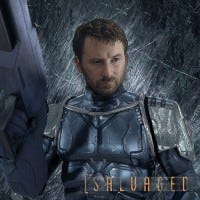Reworking Salvaged's Environments Post Rezzed
An update on the new approach for creating environments in Opposable Game's Salvaged.


Christmas has long since passed and summer is fast aproaching not that you can tell out here in deepest space. And what's space full of? Aliens. Obviously aliens. But what else? Mostly walls, bags of walls, and floors - don't forget floors - or ceilings, but really it's all about the walls. Fortunately the new year has brought more than an icy frost to the hull of our ship. New fodder to the 3D department in the form of Mike has arrived meaning I can land the job of building dingy pipe covered space wall after wall on him.
Building walls is actually pretty cool when they exist out in the furthest reaches of the cosmos. No self respecting commander of the Death Star would paint the interior a safe pale magnolia and neither will we. Even NASA or the cosmonaughts of Russia would cover the walls of their primitive pre 21st century ships in wall to wall monitors, flashing buttons and networks of pipes. I do like to imagine the Cosmonaughts might have a bit of taxidermy in there also though; a stags head mounted above the navigation console or giant stuffed grizzly bear standing next to the escape pods. Games tend to require vastly more environmental assets than they do characters and creatures hence the obsession with walls. They've gotta be cool as your games gotta be cool. But they can't be too cool... they need to sit within the world and not distract from the action and they need to be repeatable; so anything overly distinctive is dangerous. Hitting that sweet spot is a challenge - just ask Lukas Roper's mum.
 Things have changed notably from the first iteration of Salvaged we took to Rezzed last year. Before we relied on an entirely procedurally generated system consisting of 4 by 4 meter blocks of level that were stapled together at run time. This played havok with our rendering capabilities resulting in hundreds of objects on screen at a time using a ton of different textures and materials. Remember we're already rendering the game 4 times each frame for each soldier's head cam, and then rendering all of that again as you view it on your in game monitor. You can double that again if you're using the Oculus Rift. You need to keep drawcalls to a minimum which means keeping your separate textures to a minimum also.
Things have changed notably from the first iteration of Salvaged we took to Rezzed last year. Before we relied on an entirely procedurally generated system consisting of 4 by 4 meter blocks of level that were stapled together at run time. This played havok with our rendering capabilities resulting in hundreds of objects on screen at a time using a ton of different textures and materials. Remember we're already rendering the game 4 times each frame for each soldier's head cam, and then rendering all of that again as you view it on your in game monitor. You can double that again if you're using the Oculus Rift. You need to keep drawcalls to a minimum which means keeping your separate textures to a minimum also.
The new approach is to have a large set of predefined room shells that can be randomly placed within the level. These then contain a procedurally generated set of monsters and objects to greet the player on discovery. Now each shell exists as a single mesh which will share the minimum number of materials possible and saving plenty of processing power. The shells can now also be light mapped as they're pre-defined in the editor; dramatically dropping the amount of dynamic lighting. However all these rooms shells now need to be created lovingly by hand as opposed to randomly generated. This leads to more artistic input but vastly more time required from the art department. Mike's no longer allowed to sleep, he's also starting to wear his fingers down from prolonged keyboard usage. Lukas has a calender of 'jokes' he likes to read in the morning meetings so I've taken to gathering the little discarded slips of paper, rolling them up and jamming them into the ends of Mike's fingers to prolong the use of his hands. He's not as dexterous as he used to be but has learned not to complain.
 Another bonus to the system redesign has been the opportunity for the concept artists to get ahead of the 3D team on specking out environments. The world of Salvaged is becoming cohesive and full. With the writing largely laid out relating to the history and factions of the universe the conceptors have plenty to go on with their illustrations. Looking at a blank canvas can be pretty daunting (at least it is to me) and having a character bio to start with, or the purpose of a location and information on the people who built it really, start to fire the imagination. This in turn turns into detailed schematics that can be created in 3D. You can concept stuff out directly in 3D but it's generally more time consuming than with a pencil; the polygons start to demand your attention too early on, getting in the way of the design principles. Would it be possible to have Dan (our writer among other roles) produce a bio for each wall panel? I'll be sure to ask.
Another bonus to the system redesign has been the opportunity for the concept artists to get ahead of the 3D team on specking out environments. The world of Salvaged is becoming cohesive and full. With the writing largely laid out relating to the history and factions of the universe the conceptors have plenty to go on with their illustrations. Looking at a blank canvas can be pretty daunting (at least it is to me) and having a character bio to start with, or the purpose of a location and information on the people who built it really, start to fire the imagination. This in turn turns into detailed schematics that can be created in 3D. You can concept stuff out directly in 3D but it's generally more time consuming than with a pencil; the polygons start to demand your attention too early on, getting in the way of the design principles. Would it be possible to have Dan (our writer among other roles) produce a bio for each wall panel? I'll be sure to ask.
About the Author(s)
You May Also Like







.jpeg?width=700&auto=webp&quality=80&disable=upscale)








